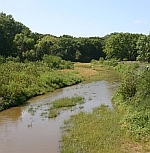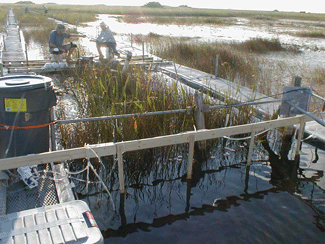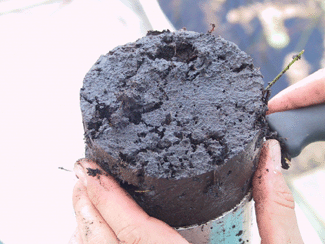Hydroecology of Flowing Waters

Recently we conducted a tracer experiment in central Shark Slough, Everglades National Park, at one of the Florida International University phosphorus dosing flume facilities. Each flume consists of 4 side-by-side channels, each enclosing a 3-m wide by 100-m long flow-way oriented with the natural direction of surface-water flow. The purpose of the experiment was to characterize transport of both solutes and fine-particles in Shark Slough, including surface-water exchange with subsurface water in the floc and underlying peat.

View of tracer injection looking downstream, salt solution and pumps to left, tubing distributes tracer solution to four soaker hoses oriented horizontally (attached to wood frame).
The experiment consisted of a constant-rate injection for 22 hours of a sodium bromide (NaBr) solution made up in 0.2-m filtered Everglades water. The injection was accomplished using two metering pumps to deliver the tracer; dividing the flow between four soaker hoses (2.65-m long) stationed horizontally across the channels at evenly spaced depths. After termination of the NaBr injection, fine particles composed of titanium dioxide (TiO2) were injected into the flume for a period of six hours. Sampling for the tracers began before the start of the NaBr injection and lasted for 48 hours. Concentrations of both dissolved and particulate tracers were monitored in surface water at distances of 6.8, 26, 43, and 86m down the channel from the injection site. In addition to sampling surface water, porewater was sampled at two locations at a distance of 6.3 m downstream from the injection site.
These experimental results will provide fundamental information about transport processes in the Everglades. Parameters describing solute and particle transport will also be available as inputs for the water-quality and landscape-process models that are currently guiding restoration planning in the Everglades. The expectation is that results can be combined with complementary chemical data such as phosphorus concentrations to better characterize rates of biogeochemical reactions in the Everglades.
First reliable quantification of recharge and discharge in interior wetlands of the Everglades. Results from different methods (seepage meters, Darcy-flux calculations, and combined surface water and chloride balances) agreed closely (Harvey, Krupa and Krest, 2004, in review; Choi and Harvey, 2000;).
Determined that recharge and discharge have both increased in the north-central Everglades relative to pre-drainage conditions. The main causes were subsidence in the agricultural area, and compartmentalization of the wetlands between levees. One effect of increasing surface water and ground water interactions in the north-central Everglades is an increase in the recharge of dissolved constituents, including contaminants. For example, dissolved total mercury is being recharged through peat into the underlying Surficial aquifer (composed of sand and limestone) (Harvey et al., 2002). The fate of mercury recharged to the aquifer, including the possibility of re-release back to surface water, is presently unknown.
Used lab and field-tracer experiments to show that water flow through coastal wetland sediments occurs primarily through macropores. Macropores are created by root growth and decay, and occupy approximately 10% of the pore space in the sediment (Harvey, 1993). Applied new techniques to show that sediment chloride budget explainable only if infiltration and evaporation fluxes are segregated between macropores and the remaining matrix of fine pores, respectively (Harvey and Nuttle, 1995). Results helped resolve a long-standing argument about how salt marshes maintain low enough salinity for plants to thrive. This work also made possible subsequent advancements demonstrating the importance of preferential flow to biogeochemical reactions of nutrients and their export to surface water (Harvey et al., 1995).

Core 'slice' of wetland sediment shows natural distribution of 'macropores' that allow preferential flow of water and solutes within a matrix of fine pores.